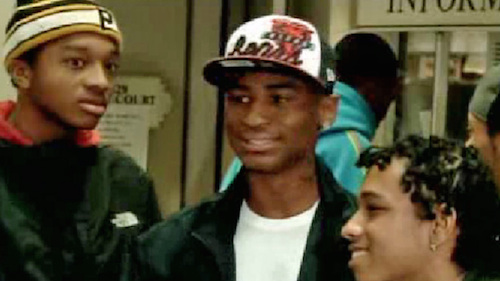
Jamal Knox, Rashee Beasley and another unidentified person, in a grainy photo with no cutline courtesy of KDKA Pittsburgh
Remember when Johnny Cash went to prison for confessing to a Reno-area murder in “Folsom Prison Blues?” I’m joking, of course: Johnny Cash was white. In unrelated news, two Pittsburgh rappers have been found guilty of intimidation of witnesses, conspiracy and making terroristic threats on the basis of a rap video posted on YouTube. Jamal Knox and Rashee Beasley are rappers in the same sense that they are adults, which is to say technically. But they did rap about violence against police officers in a song that mentioned two Pittsburgh cops by name. Both were sentenced to prison by Judge Jeffrey Manning, in what the Times calls a nationwide trend of prosecutors using rap lyrics as evidence in criminal trials.
Before we get into the weeds, let’s look at Judge Manning’s response to defense attorneys’ claims that the rap video in question was protected speech under the First Amendment:
It is abundantly clear to me that the conduct of the defendants here is not protected by the First Amendment because it far exceeds what the First Amendment allows. They did, in fact, attempt to intimidate and communicate a threat. The rap video, by its very nature, is a communication.
Gentle reader, beware the person who constructs an A because A sentence, as he has no use for reasons. Declaring from the bench that the First Amendment does not protect a given conduct because the conduct isn’t covered by the First Amendment reveals a frightening lack of deliberation, and Manning’s followup explanation isn’t much better. When we’re talking about whether someone communicated a threat, the salient question is not “were they communicating?”
I agree, though, that the rap video is a communication. So is the country music video, the novel, the painting. As the Times and several other sensible commentators have pointed out, we don’t argue in court that the authors of novels and the painters of paintings reveal their true characters in their work. So why do we do it with gangsta rap?
One suspects that part of it is because so few of us encounter gangsta rap in our daily lives, and so we fall back on the instinctive assumption that the artist’s desires are reflected in the work. Back when fictional narratives were first being developed, people were probably like, “Sophocles wants to do it with his mom!” Guided exposure has trained us out of this reflex when it comes to art and literature and Arnold Schwarzenegger movies, but we revert to instinct when confronted with an unfamiliar form.
Also, the artist’s desires are reflected in his work. It’s just that they are almost never reflected exactly, and the degree of autobiographical fidelity varies wildly. For example, I wrote a story about a frightened bumbler who almost gets tortured by a space monster, but while I am scared and incompetent, I have never been to space. Lena Dunham wrote a story about an entitled narcissist who gets accepted to the Iowa Writer’s workshop, and while she has lived a life of unearned privilege and solipsism, she also got to make an HBO show about herself.
My point is that the degree to which art imitates life varies. Rarely, though—I would go so far as to say never—does it imitate so closely as to meet the evidentiary standards of a court of law. Except when it comes to black people, apparently.
The New York Times doesn’t come out and say it, but none of the men whose rap lyrics have been used as evidence against them were white. Maybe the criminal justice system is willing to use rap as evidence despite accepting the inherent fictionality of other forms because its perceptions of inner-city minorities are inordinately influenced by fiction. What are young black men like? They’re thugs; just listen to rap music. Who grows up in the inner city? Urban super predators—just read Time magazine.
The educated, largely middle- and upper-class people who become judges and prosecutors understand lower-class urban life primarily through mediated experiences: the news, movies, television shows, et cetera. Is it therefore surprising that they accept another mediated experience, gangsta rap, as a true document? The criminal justice system is not monolithic, of course, and not every judge regards rap as the frightening reflection of a scary people. That so many do, however, is a testament to how separated our culture of justice can be from the people it is supposed to serve.




Thanks for shining your light on a fascinating subject. However, I don’t think judge Manning’s sentence is “A because A”. He found the defendants “did, in fact,attempt to intimidate and communicate a threat”. That is why he holds their conduct “far exceeds what the First Amendment allows”. If the fact finding is correct, then the legal conclusion follows. The interesting question, as you point out, is whether the finding is warranted. For that, context is everything. If a man died of gun shot wounds in Reno and the man’s blood spatter was found on Johnny’s boots, it’s not a great leap to conclude that his lyrics are evidence relevant to the issue of whether Johnny purposely or knowingly shot the man just to watch him die.
It’s very effortless to find out any matter on web as compared
to books, as I found this piece of writing at this website.
Thankfulness to my father who shared with me regarding this website, this weblog is really remarkable.
You will find plenty of slides and two independent warm and that means you
don’t feel overcrowded.